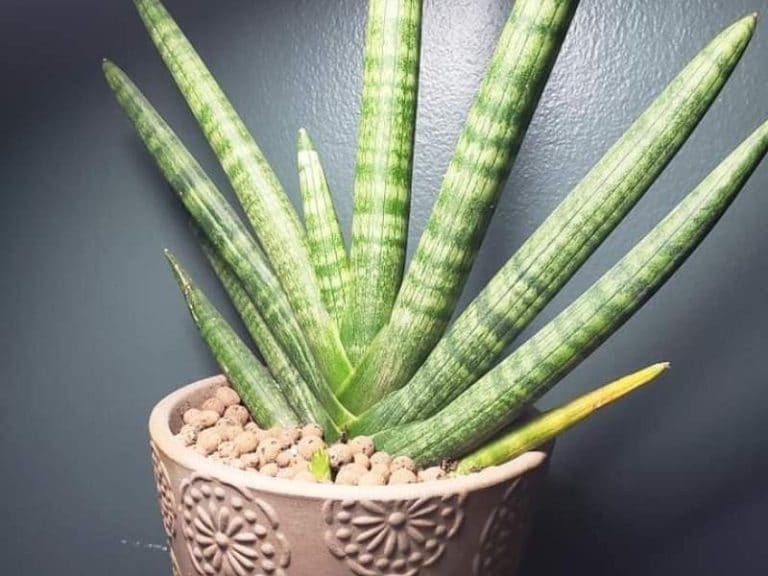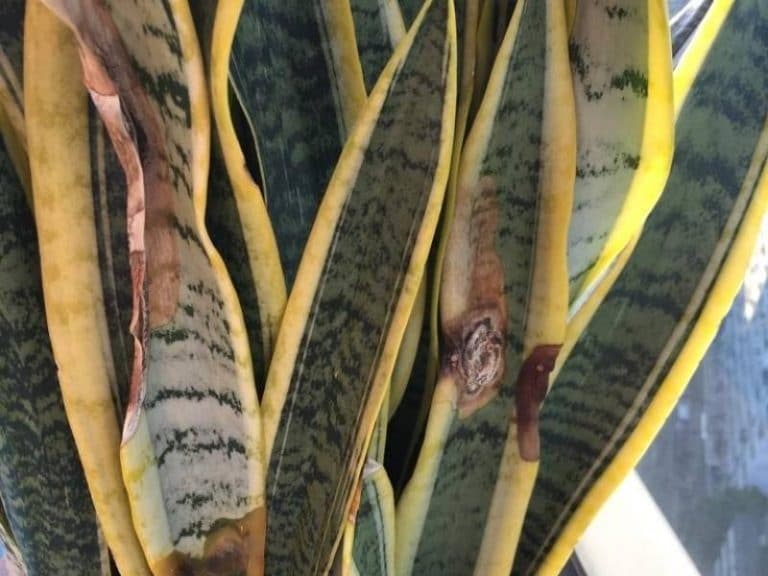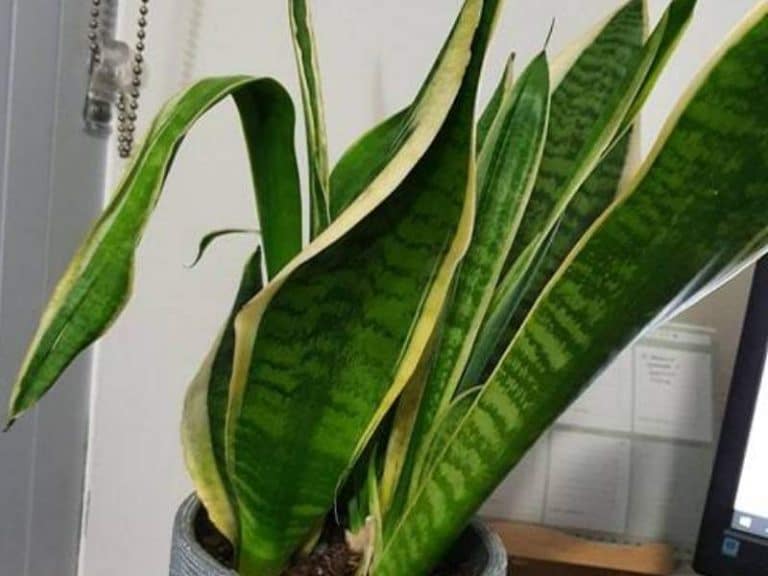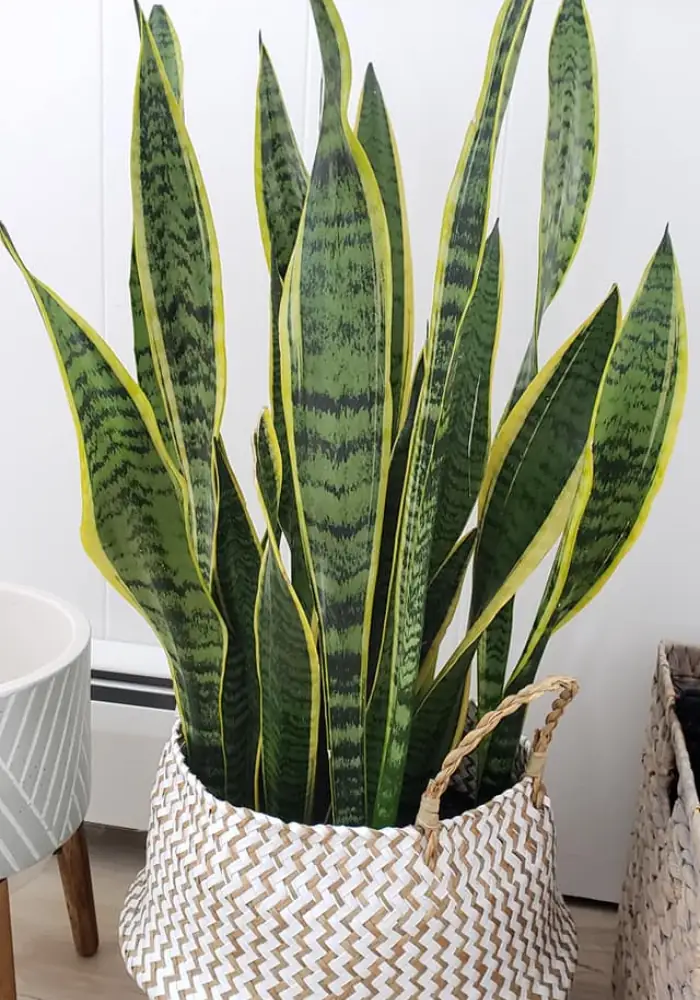Brown Tips and Spots on Snake Plants – Causes and Fixes
Brown spots on the leaves are a sign that something is wrong with your snake plant. The spots occur as small patches or dots of discoloration on the foliage – sometimes on the stems as well. Depending on the cause, some leaves can also develop brown tips.
Brown tips and spots on snake plants are a sign of overwatering, pests, or fungal diseases. Provide indirect light and water the plant once a week, allowing the top inch of soil to dry between waterings. Treat fungal diseases and get rid of mealybugs and spider mites to fix the brown-black patches.
As you’ll see below, brown leaf tips can be a sign of a problem that’s totally different from what’s causing brown spots all over the plant. As such, the fixes may also vary.
What Causes Brown Spots on Sansevieria?

Plant stress due to moisture, light, humidity, pH, and fertilizer problems can lead to brown spots and leaf tip discoloration in sansevieria plants. If not taken care of early enough, this symptom can lead to the death of the plant.
Here are the causes of brown spots on snake plants:
The snake plant problems can be many, but commonly, sansevieria can develop brown spots because of pest infestation, cold stress, fungal disease, chlorine water, overwatering, and underwatering.
Fungal Disease
Snake plants can easily be affected by fungal diseases, as their leaves retain more moisture for longer periods than most indoor plants. Altering your watering routine makes your snake plant vulnerable to fungal disease. Red leaf spot, southern blight, and rust are the three most common fungal diseases likely to attack the plant.
- Red leaf spot is a complex fungal disease caused by the Helminthosporium pathogen that thrives in warm and wet conditions. A red or brownish-red sizable spore shaped like cigars on your snake plant indicate it’s suffering from the red leaf spot.
- Rust is a fungal disease that’s common in tomatoes, beans, lawns and snapdragons. However, it can affect the snake plant too. It mostly affects matured plants, but not always. In its early stages, it affects the white raised area underneath the leaves or near the snake plant stems. The white spots turn orange-brown, then black if the infestation grows.
- Southern blight is also known as southern wilt or southern root rot. A fungus, Sclerotium rolfsii that prefers a warm environment causes it. Apart from the brown spots, your snake plant will appear droopy when infested by southern blight. Leaves start yellowing and turn light brown if not treated. The entire plant may collapse and die when the fungus wraps around the roots, messing with the entire soil.
Pest infestation
Most indoor plant pests prefer the snake plant to other indoor plants. Examples include spider mites and mealybugs. An average spider mite is around 0.04 inches, and a lot of them can gather on snake plant leaves at the same time.
Once the spider mites or mealybugs settle in, they start eating the cells of the snake plant as they suck out the sap inside. The spots where the spider mites suck turn to brown spots. When the infestation is severe, the snake plant’s leaves will start to curl and lose shape.
Chlorine water
Most public water supplies disinfect their water with chlorine to eliminate bacteria, viruses, and pathogens that cause diseases. However, using chlorinated water while watering snake plants can lead to their leaves turning brown due to the excess salt content that can burn the root zone leading to poor nutrient and oxygen absorption.
Cold temperatures
Snake plants aren’t winter-hardy, and exposing them to a cold freezing climate can lead to damages that are visible on the leaves as brown spots. When temperatures are below 50°F, the leaves get scars and develop brown patches, with a little mushy texture. These damages are permanent.
Plant injury
Physical damage can cause sansevieria to develop brown patches. If you buy a plant online, it sometimes gets damaged during transportation. Moving sansevieria from one location to another may also cause harm to the outer foliage.
What Causes Brown Tips on Snake Plants?
Several reasons may lead to brown tips on snake plants. One of the major reasons is moisture problems, so checking the pot for adequate moisture is the first place to start the troubleshooting.
Here are the causes of brown tips on snake plants:
Inconsistent watering
Both overwatering and underwatering in sansevieria can immensely affect the plant. Underwatering occurs when snake plants have stayed a long period without receiving water. The plant becomes dehydrated after using all the water it had stored. The leaves would then be turning crispy, with brown tips.
Leaf discoloration is always the first sign of an overwatered snake plant. They first begin drooping before a blister forms on the surface of the leaves. The bloated leaves look brown as they lack certain nutrients. Sometimes, the potting mix can be a problem. When the soil becomes dense like mud, it can become too wet or concrete dry, then suffocate the roots making the plant unhealthy.
If not reversed early, overwatering can lead to the death of plants.
Low humidity
Sansevieria plants thrive in a humid environment and struggle in dry air conditions. Low humidity in the air may cause the snake plant tips to turn brown.
Mist your snake plant every week with a spray bottle if your place has dry air to prevent and fix brown tips on your snake plant.
Too much direct sunlight
Snake plants love indirect sunlight and can make good fast growing plants in the right conditions. Without the right light conditions, your snake plant is likely to develop brown spots on its leaves. For instance, when the plants grow in a dimly lit room and you decide to move them to a bright room for them to receive full light, they might get stressed.
The sudden changes of lighting might lead it to become brown, especially at the tips. When the sun is too hot and direct, snake plant leaves will also start to form wrinkles.
Excessive fertilizer
The snake plant doesn’t need lots of fertilizers since it can survive on nutrient-deficient soil. Too much fertilizer can burn the roots, thus impacting the foliage leading to brown tips or brown leaf edges. If you notice the leaf tips browning a few days after fertilizing, excess nutrients may be the cause.
How to Treat Brown Spots on Snake Plant Leaves
The first step to fixing brown spots is identifying the primary cause before starting the treatment. Severe damage is hard to reverse. However, with the proper care, over time, your plant may start looking healthy.
Here’s how to fix brown spots on sansevieria:
1. Treat fungal diseases with a fungicide
Whether it’s suffering from red leaf spot, rust, or southern blight, sort out quick remediation. If a fungi disease isn’t treated, it can quickly spread and kill the entire plant.
Isolate the infected plant from the rest to avoid the disease from spreading to healthy plants. Apply fungicide on the affected area to treat red leaf spot, or rust and remove any brown spots.
Alternatively, create a DIY chemical-free anti-fungal treatment at home by mixing dishwashing detergent and bleach. Ensure that the detergent doesn’t have degreasing ingredients. Wear gloves during this process.
Pro tip: Disinfect your garden sheers before and after finishing to avoid spreading the disease to other parts of the plant.
Also, you can mix a gallon of water with 4 teaspoons of baking soda or 4 teaspoons of bicarbonate.
To combat southern blight, heat-treat the soil. But first, separate the healthy soil from the unhealthy soil. Set the heat mat to around 160 or 180 degrees. Leave the soil to sit there for half an hour at the same temperature before turning the heat mat off. Alternatively, just change the soil.
2. Water using distilled or rain water
If you suspect your plant’s leaves have discolored because of chlorine water, try rain or distilled water. Alternatively, fill a container with tap water and let it settle for at least 48 hours before watering the snake plant. Here, the water will naturally dissipate hence remain safe.
3. Get rid of plant pests
Start by removing spider mite webs and the brown spots before applying garden-safe insecticides like horticultural soap or neem. If the problem is mealybugs, apply isopropyl alcohol by rubbing it on the bug.s Be careful while applying, as lots of isopropyl alcohol can lead to leaf burn.
4. Water the plant once per week
Snake plants don’t require much watering. Once a week or less is enough. Only water the plant when the top inch of the soil is dry. When watering, add enough water to moisten the soil.
At least once a week, check if your snake plants need water. Stick your finger or chopstick an inch deep inside the soil, and if dry, it could be time for watering. If wet, hold back on the watering.
Pro tip: Snake plants require watering once every two weeks during summer and once every month during fall or winter. Ensure your pot has good drainage holes to avoid soaking the roots that can lead to root rots.
5. Provide indirect light
Place a snake plant near light curtain-covered windows to receive indirect but enough light. If you want to move the plant to a shaded area, gradually expose it to light before making any drastic changes.
How to Fix Brown Tips on Snake Plants
Give your sansevieria a second chance by fixing those brown tips. The following are tips you can apply.
Flush Down Excess Fertilizer
Run a lot of water through the potting mix to get rid of excess fertilizer salts out of the soil. Stop fertilizing for at least a few months to revive the snake plant and resume the process once it looks healthy again.
The best time to fertilize is during a hot weather. Once during summer is enough. Don’t fertilize during fall or winter as it’s the snake plant’s resting period. Also, avoid fertilizing sick and young plants; or after repotting snake plants.
If a must, apply slow or liquid fertilizers sparingly. A standard all-purpose fertilizer or organic mixes are great options. Preferably, use a diluted fertilizer.
Protect the plant from cold damage
Unfortunately, you can’t reverse damage caused by freezing weather. However, if only a tiny part of the leaf is affected, cut off the part using a sharp, sterile tool. If the leaves are all mushy, cut them off at the base. In case the roots aren’t affected, new leaves are likely to sprout.
To avoid the problem, protect your plants from low temperatures. If your snake plant is outdoors, bring it inside during winter.
Brown tips and brown spots can be serious snake plant problems. However, identifying the cause early and rectifying it is what you need to save your plant.








When a sansevieria is not doing well the first thing to do is take it out of the pot and remove the soil and check the roots. If the roots are healthy and the plant is withered, soak the plant in slightly warm water overnight and repot. If the roots are rotted, clean off all the rotted stuff and dust it with rooting hormone, then report and water sparingly.
My snake plant is approx 2 feet high. One of the leaves half way up had a soft to touch brown spot. It is about 1/2 inch. Do I cut that leaf off or what do you suggest.
Thanks,
Ed
I live in Ohio…cold winters. My apt is very draft and cold air is all around us. I don’t know where I can put my guy to keep him warm. But I will try.